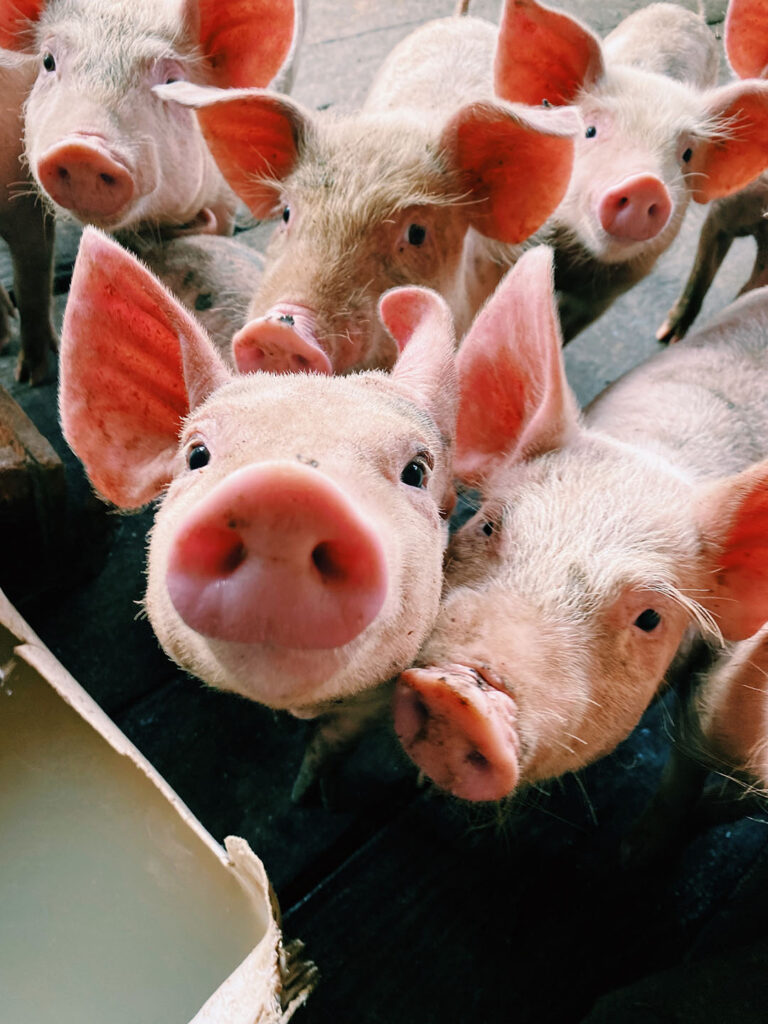Dietary supplementation of phytase for piglets and broilers

Post-weaning and hatching, piglets and broilers start consuming diets with greater amounts of plant-based feedstuffs. These diets comprise various antinutritional factors. Feed enzymes such as phytase are used to increase nutrient digestibility and growth performance.
Phytate, a mixed salt of phytic acid, is constantly present in plant-based feedstuffs. Phytic acid is an antinutritional factor that reduces the absorption and digestibility of trace minerals, such as calcium, zinc, and copper, forming insoluble and indigestible compounds. In addition, phytic acid binds to amino acids, proteins, and enzymes, thus preventing their activity and digestibility. Factors including genetics, climate conditions, location, irrigation, soil nutrition, season, and fertiliser application affect the level of phytic acid in the plant-based feedstuffs.
Approximately 70% of the phosphorous content in cereal grains and oil seeds used in piglets and broilers diet exists in the form of phytic acid. Moreover, phytic acid is soluble under the acidic pH of stomach of pigs and proventriculus of broilers and it is less susceptible to binding to other nutrients, reducing their bioavailability.
Phytase characteristics
Phytase is a feed enzyme responsible for catalysing the hydrolysis of phytic acid, thus increasing the bioavailability of nutrients, especially phosphorus. This leads to benefits in terms of nutrient digestibility, bone health, growth performance, composition and diversity of the gut microbiota, as well as the gut health of piglets and broilers. In addition, phytase is a heat-labile enzyme and susceptible to high temperatures applied to some feed mixing processes.
Monogastric animals lack endogenous phytase production; therefore, their diet includes high levels of inorganic phosphorous sources to meet their nutritional requirements, which in turn increases the costs associated with feed. Furthermore, excretion of undigested minerals in the manure results in soil and water contamination.

Phytase mechanisms of action
Phytase increases the bioavailability of phosphorous using a series of stepwise dephosphorylation reactions. Phytase activity is expressed as phytase units that describe the amount of phytase needed for the release of 1 µmol of inorganic phosphorous per minute from an excess of 15 µM sodium phytate at pH 5.5 and 37◦C.
Since the pH in the small intestine is more favourable for proteolytic enzymes, there is a possibility that phytase could be broken down or inactivated by other active endogenous proteases. Factors including heat, diet composition, storing conditions, as well as gastric pH and temperature affect the optimal activity of phytase.
The 3- and 6-phytase
New phytase types developed by manufacturing technology are classified based on the form, microorganism sources, optimal pH range, and the position of the carbon where the dephosphorylation and the hydrolysis of the inositol ring starts.
The 3-phytase initiates the dephosphorylation at the third carbon atom of the inositol ring, and the 6-phytase begins at the sixth carbon atom, which increases the hydrolysis of the inositol ring. The 6-phytase is more active and resistant than 3-phytase in the gut environment. In addition, due to benefits associated with the mode of action of 6-phytase, this enzyme is more commonly used in pig and poultry production systems.
Dietary supplementation of phytase
Supplementation of both 3-phytase and 6-phytase improves the average daily gain of broilers and piglets. However, the results of research studies showed that 6-phytase could be supplemented at similar levels to 3-phytase and still provide greater improvement in the average daily gain of the animals.
Supplementing phytase beyond the traditional level – also known as “super dosing” – leads to a greater increase in average daily gain, phytic acid dephosphorylation, phosphorous bioavailability, and better improvement in the gut health of pigs and broiler chickens.
Impact of phytase supplementation on broiler gut health
Dietary supplementation of phytase increased the relative abundance of Lactobacillus and reduced the relative abundance of Helicobacter and Pelomonas populations of the mucosa-associated microbiota in the jejunum. All these changes in gut microbiota composition were due to pH alterations caused by a reduction in dietary calcium levels, and by the active hydrolysis of the phytate-complexes that increase the bioavailability of calcium.
In addition, adding phytase to the diet increases the jejunal villus height, and apparent ileal digestibility of nutrients. However, phytase does not impact the inflammatory and oxidative stress parameters in the gut. In broiler chicken fed phytase there was a reduction in the relative abundance of Streptococcus populations in the ileum due to the production of short chain fatty acids and alterations in the pH values in the crop, ileum and caeca.
In addition, phytase supplementation increases lactate and acetic acid production in the ileum, which are antioxidants and a potential bacterial substrate with positive effects on the gut microbiota.
Impact of phytase supplementation on piglet gut health
Phytase supplementation increased villus height in the duodenum, and jejunum, and the villus height to crypt depth ratio in the duodenum. In addition, adding phytase reduced the concentrations of tumour necrosis factor alpha in the duodenum and malondialdehyde in the jejunum. Another possible mechanism of phytase related to gut health is the increase in plasma myoinositol, and serum zinc and copper levels in nursery pigs.
In addition, phytase supplementation has positive effects on the growth performance of the pigs during their first ten days post-weaning, due to the greater generation of myo-inositol and other essential minerals. In addition, phytase increases the concentrations of glucose transporter type 4 in the muscle plasma membranes, thus enhancing tissue glucose uptake during insulin signalling.
Factors affecting gut microbiota in pigs
Concluding remarks
Dietary supplementation of phytase for piglets and broilers enhances nutrient digestibility, bone health, and growth performance, reduces oxidative stress parameters, modulates gut microbiota, and improves gut health, and welfare. The 6-phytase seems to be more effective and provides a wider range of benefits compared to 3-phytase. However, since phytase is sensitive to high temperatures and humidity, proper storage and handling procedures should be followed to maintain the efficacy of the product.











